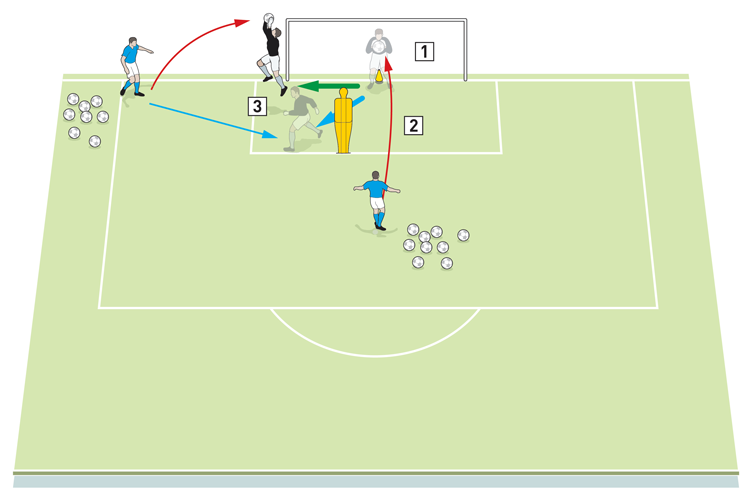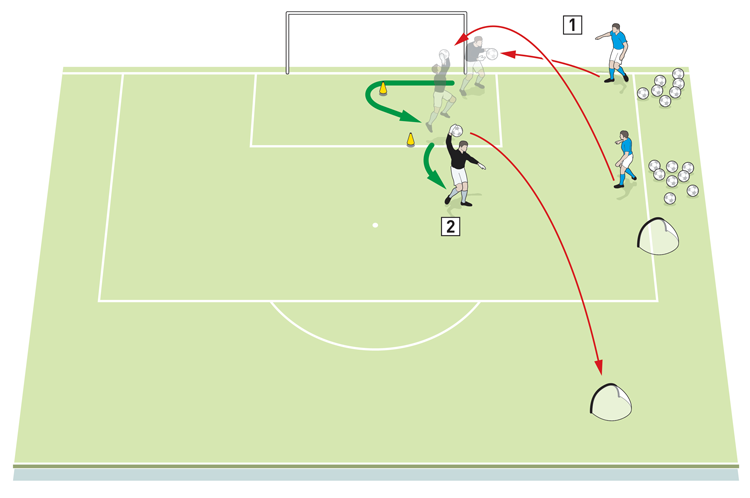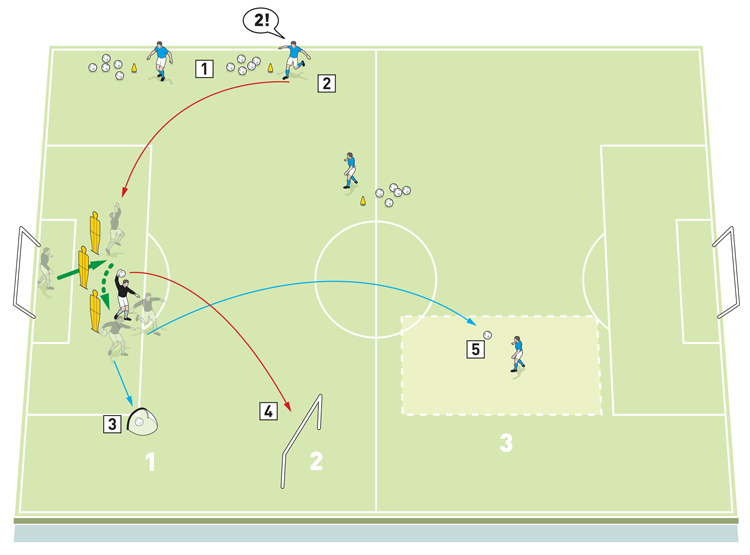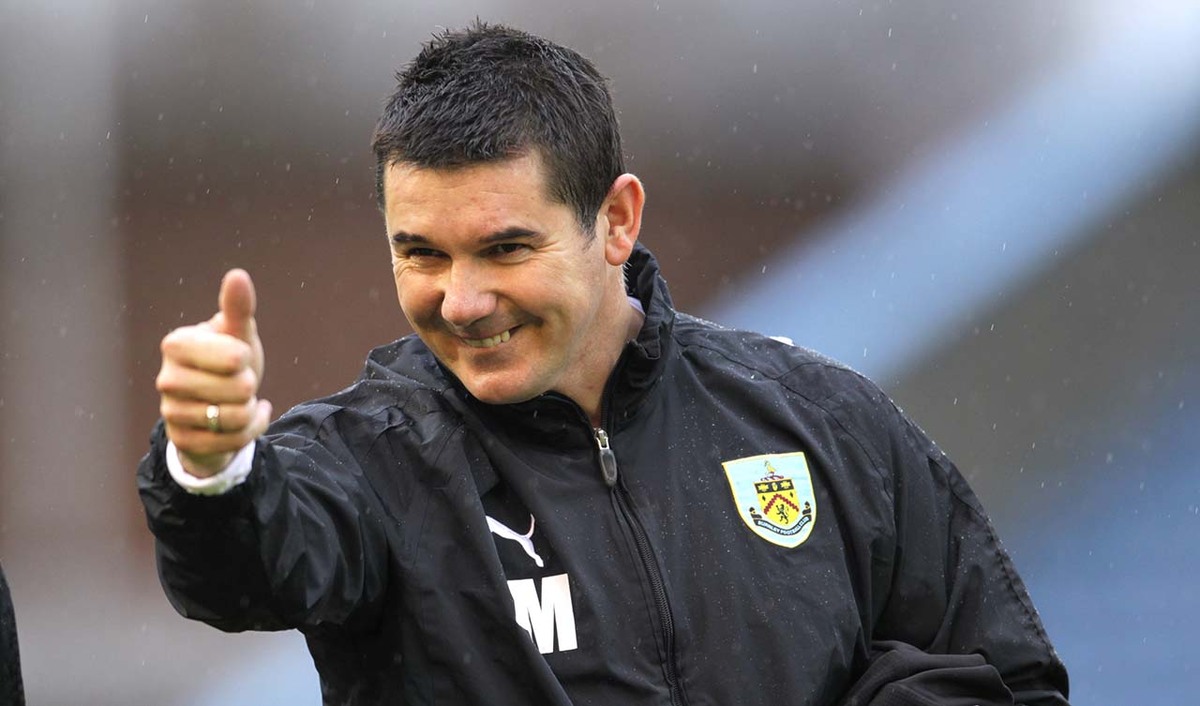




OUR BEST EVER OFFER - SAVE £100/$100
JOIN THE WORLD'S LEADING PROFESSIONAL DEVELOPMENT PROGRAMME
- 12 months membership of Elite Soccer
- Print copy of Elite Player & Coach Development
- Print copy of The Training Ground
Keepers: crossing and distribution
This is a keeper session that looks at dealing with crossing then distributing into counter-attacking areas beginning with a good warm-up before moving into basic handling drills, then progress to dealing with crosses and distribution, starting off unopposed then putting in defenders and attackers.
| Area | Use of a half-pitch |
| Equipment | Balls, cones, goals, mannequins, mini-goals |
| No. of Players | Keeper plus 3 servers |
| Session Time | 45-70mins |
This is a keeper session that looks at dealing with crossing then distributing into counter-attacking areas. The methods are simple but it’s vital we rehearse them well if they are to be replicated in the most efficient and dynamic way.
This is a session we will run every Thursday if playing at home on the Saturday, or Friday if away. We will try to make it as enjoyable as possible, keeping things upbeat and setting keepers achievable targets with their distribution.
We begin with a good warm-up before moving into basic handling drills, then progress to dealing with crosses and distribution, starting off unopposed then putting in defenders and attackers.
What do I get the players to do?
Quick feet warm-up (not shown)
We will begin with basic warm-up activities, with quick feet over cones finishing with a one-footed take-off over a hurdle. Typically we will vary footwork – always finishing with a one-footed take-off, but this can be one foot between each cone, into two feet between the cone as variation, then side-to-side around cones and forwards and backwards around cones.
Basic handling (not shown)
First we look to practise volleys into the keeper’s hands. First these will be in line, then the keeper steps across to catch, then turns off a cone to catch and finally he steps out a ‘figure of eight’. For each run-through it’s five from a server at the front and five from the back.
Intermediate handling (not shown).
Now we move into another handling drill whereby the keeper starts on a middle cone, takes a volley off a first server, adjusts his position to the near post then takes a high ball going back over his head. We work on both sides, six times.
The natural progression to this is to add in a second server and ensure the keeper can’t pre-empt what is to follow by serving a byline cut-back on the floor. Again we work this six times.
Dealing with crosses - basic
As shown (1a), the keeper starts in the middle of the goal facing the server. He takes a volley, then adjusts feet around the cone to take a high ball forward coming through the gate, six times.
1a

2. He takes a volley
3. He now turns towards the corner flag and must be prepared to take a catch along any point of the edge of the six-yard box
We progress this by introducing a throw into target goals, underarm and overarm, six times (1b).
1b

2. Here, too, the keeper must distribute into one of the mini-goals
Dealing with crosses - intermediate
Now we set up crossing using a keeper and two servers, as shown (2). Six crosses come from each of the four stations (so 24 crosses in total), unopposed, enabling the keeper to practise timing without distraction, and ultimately building confidence.
2

Distribution and recovery
Now, as shown (3), the keeper starts on the six-yard line, takes a volley off the server, sets the ball on the floor and drives out to the second server in the box. He then recovers to take up a positive position to deal with a cross coming back from that same server. He will perform three of these on each side.
3

2. He sets the ball on the floor and sends it out to the second server in the box
3. Now he must recover – evading the attentions of the mannequins – in order to deal with the cross coming back from that same server
We can progress this with a number of advancements that can suit keepers looking to enhance bespoke, individual skills. So it might be six throws, six side volleys or the challenge of dealing with an incoming ball without using the hands. Alternatively, the six half-volleys served from the edge of the box could be made to bounce first before being caught.
Crossing and distribution
Now we have one keeper working and three servers (4). He adopts a realistic starting position, taking a cross off each server in turn. Once he has made the catch, the server shouts either “1”, “2” or “3” whereby the keeper must hit the relevant target, as shown. Each time he distributes, the ball must be into the stated area or goal at match pace and with accuracy. We do this 12 times then switch to the other side.
4

2. The server must instruct him to send the incoming ball to targets 1, 2 or 3
3. A shout of “1” means an underarm throw into the mini-goal
4. If “2” it’s an overarm throw (one bounce and on the full) into the large target goal
5. If “3” it must be a side volley or half-volley into the target area.
As it is, the keeper is alert to the order and distributes accordingly when the shout of “2” comes – here it’s into the large target goal
What are the key things to look out for?
In every keeper we must see a good starting position, assessment of the ball and a desire to take any catch at the highest point (since this is where he is least likely to be challenged and can dominate his space). In doing this he is stepping into the line of the ball and attacking it in front of the eye line.
His decision-making must be precise and swift, with technique and choice of distribution key (and that could be with hands or feet). Once he has released the ball we’re looking for him to make recovery lines back into a default keeper position.
In a physical sense this is all represented by balance and coordination when moving into line, plus explosive movement, agility and flexibility when recovering to feet (being alert to the possibility of a second save if, for instance, the ball goes loose), upper body and core strength in dealing with the high ball, throwing technique and distance when striking the ball.
There are also a number of social and psychological factors in play that we feel add to the success of a practice. So as well as being seen to enjoy the challenges, we want to ensure concentration and focus, players growing in confidence and self-belief (both in themselves and in others), with the idea of learning and being better than they were yesterday.
They must make clear, concise, positive decisions, not allowing mistakes to affect them nor prevent them from doing the right or the same thing the next time. And crucially, we must see respect, with players building good relationships with their team mates for the good of the team.
Related Files
Editor's Picks
Attacking transitions
Deep runs in the final third
Using the goalkeeper in build-up play
Intensive boxes drill with goals
Penetrating the final third
Creating and finishing
My philosophy
Pressing initiation
Compact team movement
Coaches' Testimonials

Alan Pardew

Arsène Wenger

Brendan Rodgers

Carlos Carvalhal

José Mourinho

Jürgen Klopp

Pep Guardiola

Roy Hodgson

Sir Alex Ferguson

Steven Gerrard
Coaches' Testimonials

Gerald Kearney, Downtown Las Vegas Soccer Club

Paul Butler, Florida, USA

Rick Shields, Springboro, USA

Tony Green, Pierrefonds Titans, Quebec, Canada
Join the world's leading coaches and managers and discover for yourself one of the best kept secrets in coaching. No other training tool on the planet is written or read by the calibre of names you’ll find in Elite Soccer.
In a recent survey 92% of subscribers said Elite Soccer makes them more confident, 89% said it makes them a more effective coach and 91% said it makes them more inspired.
Get Monthly Inspiration
All the latest techniques and approaches
Since 2010 Elite Soccer has given subscribers exclusive insight into the training ground practices of the world’s best coaches. Published in partnership with the League Managers Association we have unparalleled access to the leading lights in the English leagues, as well as a host of international managers.
Elite Soccer exclusively features sessions written by the coaches themselves. There are no observed sessions and no sessions “in the style of”, just first-hand advice delivered direct to you from the coach.







